#Etsuko ikeda
Text
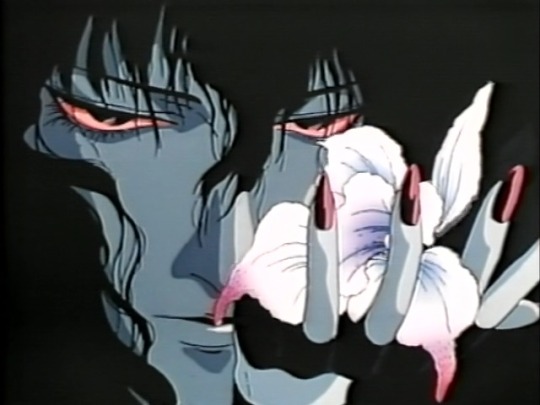
Bride of Deimos | 悪魔デイモスの花嫁, 1988
“Though the flowers may wither, their scent remains. The strong scent of suspicion. A spider unceasingly spins its web. Not resting for a moment even as you sleep.”
74 notes
·
View notes
Text

Good old shoujo...
#Akuma no hanayome#Deimos no hanayome#悪魔の花嫁#bride of deimos#Ashibe yuuho#Yuuho ashibe#あしべゆうほ#Ikeda etsuko#Etsuko ikeda#池田悦子#70s manga#retro manga#vintage shoujo#70s shoujo#retro shoujo
29 notes
·
View notes
Text

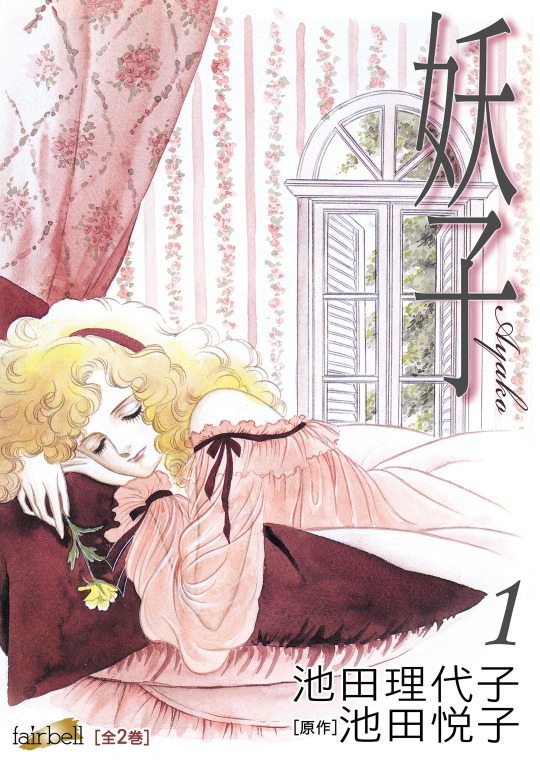

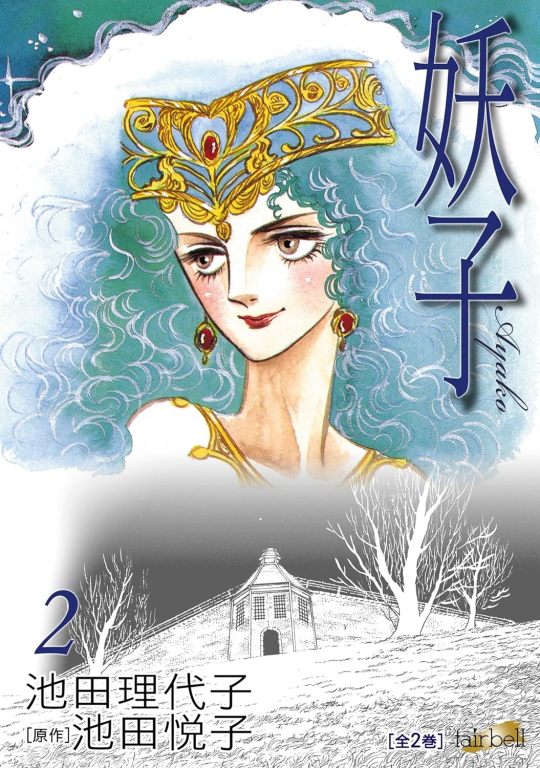
Ayako | 妖子
Riyoko Ikeda & Etsuko Ikeda
17 notes
·
View notes
Note
I know Fusion decided to do Bandori (DVHS edition) a while back, so could we have a followup? PJSK: DVHS! Four-person units plus a Vocaloid for each, featuring "you shouldn't technically be here" this time. - II
...I definitely didn't spend twenty minutes looking for this post
Dawn to Dusk:
Oshiro (leader), Matsumoto, Ikeda, and Saito
They focus a lot on composition more than anything else, and a lot of their music is said to be best played at night. That’s usually when they have the most time to work on it, too. They don’t really fit in any one genre, though, dipping their toes into everything.
Rin and Len would be their Vocaloids since I think it’d be a funny contrast between them arguing and Oshiro and Saito arguing.
Worldwide:
Ishikawa (leader), Nakamura, Yoshida, and Maeda
This group would probably focus on multilingual songs of all kinds, blending together different styles. Ishikawa of course knows lots of languages, Nakamura knows a bit of other languages, Yoshida’s just fun, and Maeda knows Russian!
Luka is their Vocaloid, since she’s known for being bilingual. I also think she would contribute to their chaos nicely.
Blossoming:
Hamasaki (leader), Fujimoto, Yasu, and Sasaki
They’re kind of like a traditional band like Leo/need, though a lot of their music is more calming. Fujimoto’s great with writing meaningful lyrics, though he doesn’t actually play with the rest of them. Hamasaki plays guitar, Yasu’s on percussion, and Sasaki’s on keyboard. All three of them trade off vocals.
Meiko is their Vocaloid, I think mostly because I associate these four with being more mature/older sibling-figures, kind of like how I think about Meiko.
On Your Feet:
Ueda (leader), Rikimaru, Abe, and Aoyama
They’re slightly more pop-focused, kind of in the realm of dance music. It’s surprising that Abe and Aoyama are part of the group in that regard, but the four of them work incredibly well together (barring some small bickering here and there).
Kaito is their Vocaloid, and I think he’d cycle between being a sort of mediator and contributing to their excellent vibes, haha.
#answered ask#anon#fusion anon ii#fumito abe#nozomu aoyama#hidekazu fujimoto#utako hamasaki#kazuhiko ikeda#camila ishikawa#yasu kadoshima#hayao maeda#takeshi matsumoto#ikuo nakamura#amaya oshiro#kirika rikimaru#kagami saito#hanayo sasaki#miyuki ueda#etsuko yoshida#danganronpa#dvhs#pjsk#project sekai#megurine luka#meiko#kaito#kagamine rin#kagamine len
3 notes
·
View notes
Text
Books & B-T
Books/stories that might have inspired B-T lyrics or albums:
Salome by Oscar Wilde
Midsummer Night's Dream by Shakespeare
Hamlet by Shakespeare
Mona Lisa Overdrive by William Gibson
Neuromancer by William Gibson
Solaris by Stanisław Lem
Do Androids Dream of Electric Sheep by Philip K. Dick
Alice in Wonderland by Lewis Lewis Carroll
Season in Hell Arthur Rimbaud
The Stranger by Albert Camus
Fantomas by Marcel Allain & Pierre Souvestre
Locus Solus by Raymond Roussel
Les Enfants Terribles by Jean Cocteau
The Fall of Icarus by Ovid
Dada Manifesto by Hugo Ball
The Surrealist Manifesto by André Breton
The Rosicrucian manifestos
The Story of Little Black Sambo by Helen Bannerman
JoJo's Bizarre Adventure by Hirohiko Araki
Hearts by Kumi Himeno
The Soul of the Night by Chet Raymo
Vita Mechanicalis by Inagaki Taruho
Books mentioned by Acchan:
Villain by Shuichi Yoshida
Kokoro by Natsume Soseki
Audition by Ryu Murakami
Coin Locker Babies by Ryu Murakami
The World Five Minutes From Now by Ryu Murakami
No Longer Human by Osamu Dazai
The Setting Sun by Osamu Dazai
Hakyoku by Tono Haruka
Kairyou by Tono Haruka
Neko Nari by Numata Mahokaru
On Decadence by Sakaguchi Ango
Confessions of a Mask by Yukio Mishima
Death Spirits by Yutaka Haniya
Living Tips by Itsuki Hiroyuki
Grotesque by Natsuo Kirino
Shiki by Fuyumi Ono
Bride of Deimos written by Etsuko Ikeda & illustrated by Yuho Ashibe
The Flowers of Evil by Charles Baudelaire
The Picture of Dorian Gray by Oscar Wilde
Crime and Punishment by Fyodor Dostoevsky
Notes from the Underground by Fyodor Dostoevsky
Other authors mentioned by Acchan:
Junji Ito
Randi Taguchi
Ryunosuke Akutagawa
Yasunari Kawabata
Natsuhiko Kyogoku
Ayatsuji Yukito
Sakuraba Kazuki
Nobuyuki Fukumoto
Hermann Hesse
Johann Wolfgang von Goethe
Sources:
nopperabou.net
Jrockarchive
This is not greatest site
Buck-Tick Zone
Vk BT group
FT bulletins
B-T profiles through the years I've saved
Personal scans & magazines
Feel free to add more books/novels/mangas <3
#i'll update this soon#cause i have more authors but i need to confirm the sources#buck-tick#sakurai atsushi#<3
67 notes
·
View notes
Text
My manga collection (October 2023)
I did a post detailing my manga collection back in 2021, but it's grown a lot since then so I figured I'd make a new post! It was also a good time to do so because we're repainting my room and while there's usually a ton of anime merch in front of the books on my shelves, now it's all been packed up. So there's a clear look at the books without me having to move anything, lol.
Anyway, without further adieu, here we go! My manga collection is largely shoujo (specifically magical girls) and horror manga.

Pet Shop of Horrors by Matsuri Akino
Pet Shop of Horrors: Tokyo by Matsuri Akino
The Clique by Yishan Li
Frozen II manga by Arina Tanemura
Dark Metro by Tokyo Calen and Yoshiken
Yokai Rental Shop by Shin Mashiba
Confidential Confessions by Reiko Momochi
Pichi Pichi Pitch (aka Mermaid Melody) by Michiko Yokote and Pink Hanamori
Magical Girl Site by Kentaro Sato
Reiko the Zombie Shop by Rei Mikamoto
Les Miserables (manga adaptation) by TszMei Lee
Nightmares for Sale by Kaoru Ohashi
Presents by Kanako Inuki
Mail by Housui Yamazaki
Dark Water by Meimu
Tale of a White Night by Tooko Miyagi
Goth by Otsuichi and Kendi Oiwa
Beautiful People by Mitsukazu Mihara
Attack on Titan: No Regrets by Gun Snark and Hikaru Suruga
In Clothes Called Fat by Moyoco Anno
A Girl on the Shore by Inio Asano
Bride of Deimos by Etsuko Ikeda and Yuuho Ashibe
Limit by Keiko Suenobu
Helter Skelter by Kyoko Okazaki
Dolls omnibus (in Japanese) by Yumiko Kawahara
Ibitsu by Haruto Ryo
A God Somewhere (Western comic) by John Arcudi and Peter Snejbjerg
Beauty (Western comic) by Hubert and Kerascoët

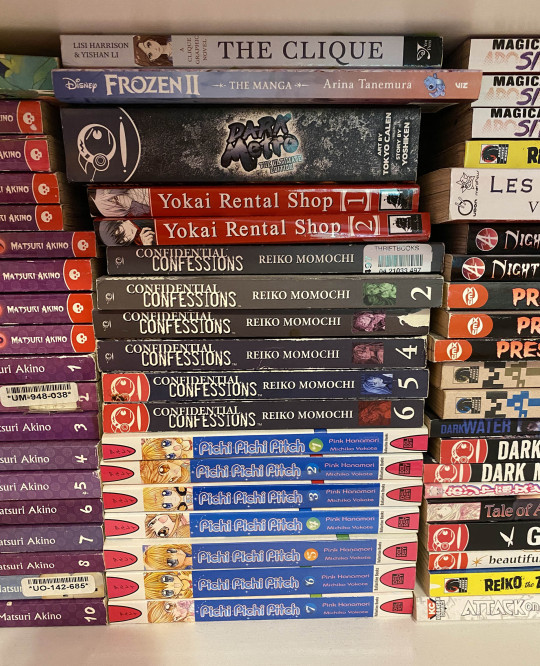

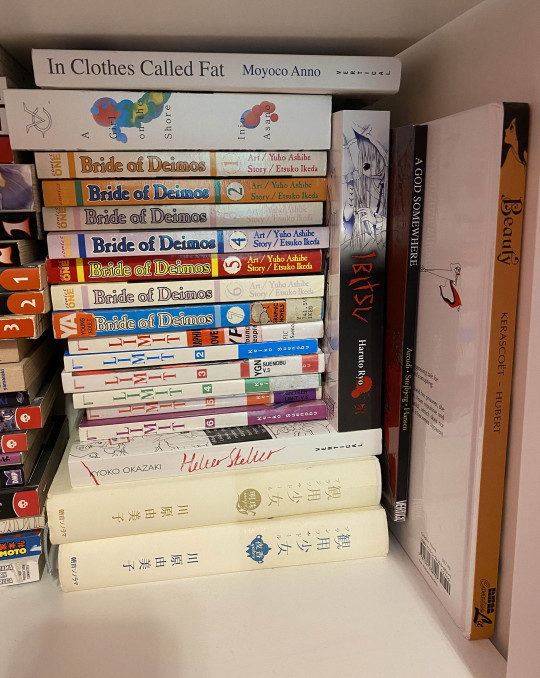
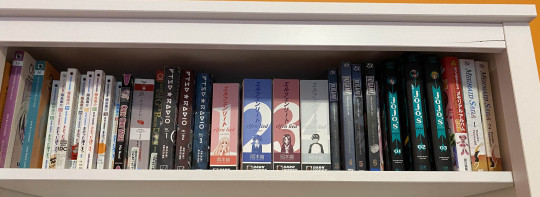
Ah! My Goddess by Kōsuke Fujishima
Only One Wish by Mia Ikumi
Higurashi When They Cry: Festival Accompanying Arc by Karin Suzuragi
Chronicles of the Grim Peddler by Lee Jeoun-A
PTSD Radio by Masaaki Nakayama
Elfen Lied by Lynn Okamoto
Ikigami: The Ultimate Limit by Motoro Mase
Happy Sugar Life by Tomiyaki Kagisora
JoJo's Bizarre Adventure: Phantom Blood by Hirohiko Araki
An Ojamajo Doremi artbook (in Japanese)
Mermaid Saga by Rumiko Takahashi
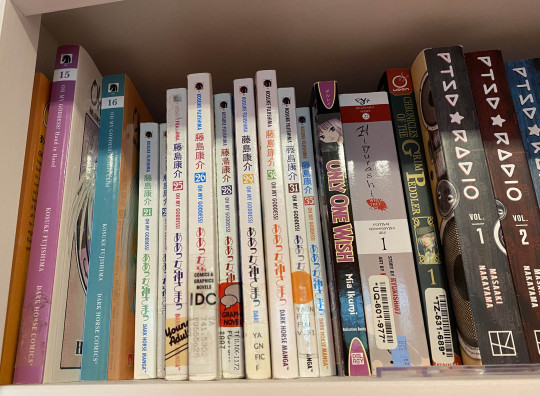
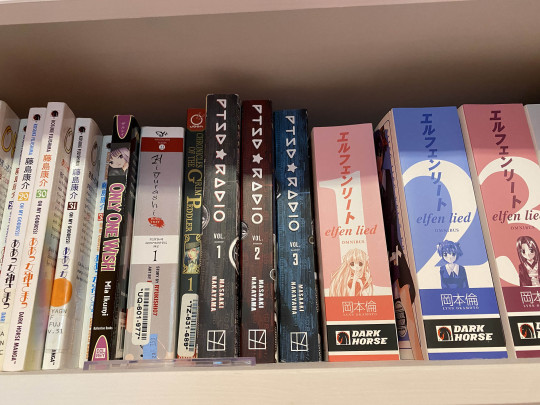

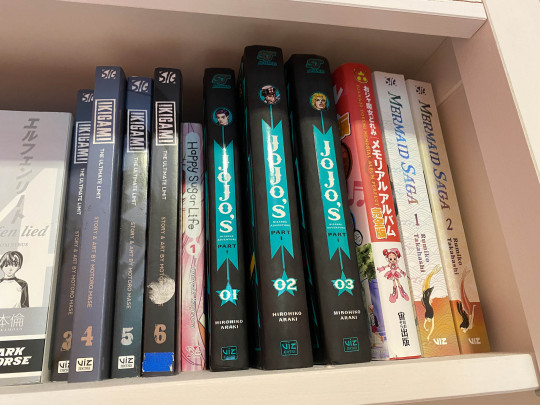

Dolls by Yumiko Kawahara
Maid-sama by Hiro Fujiwara
Franken Fran by Katsuhisa Kigitsu
Hell Girl by Miyuki Eto
Gurren Lagann by Kotaro Mori
Doll by Mitsukazu Mihara
Mantis Woman by Senno Knife
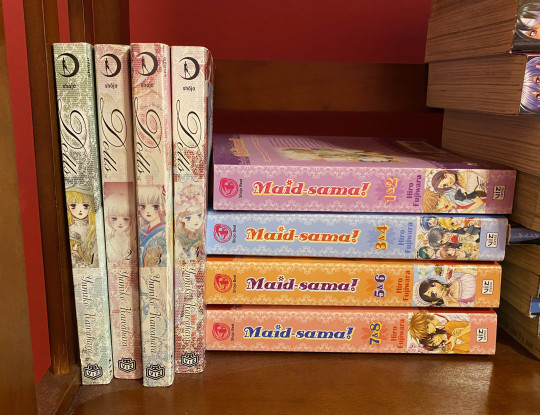
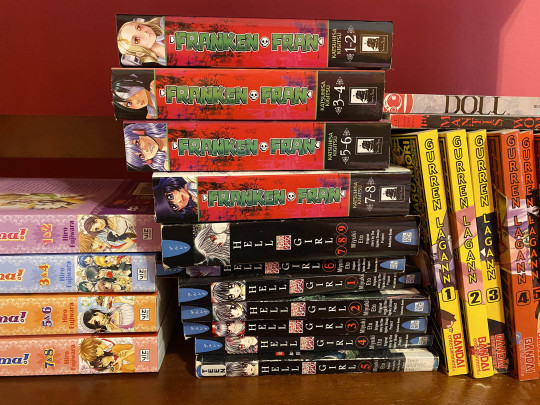
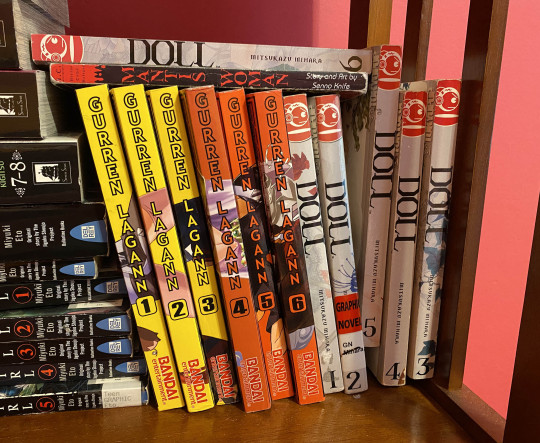
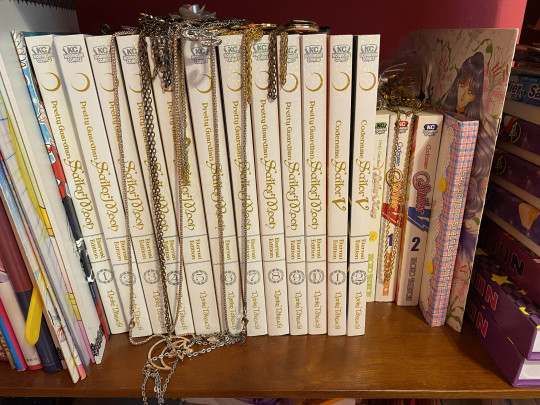
Various Sailor Moon artbooks from the anime, manga illustrations by Naoko Takeuchi, and fan artbooks
Sailor Moon Eternal Edition by Naoko Takeuchi
Sailor V Eternal Edition by Naoko Takeuchi
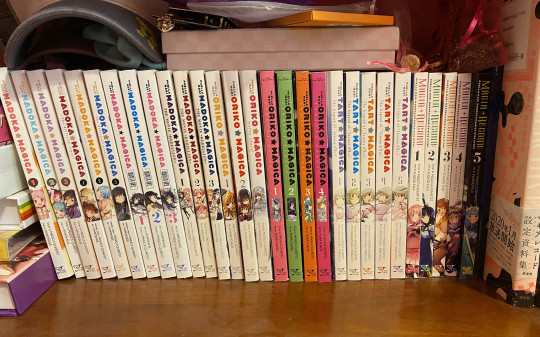
Puella Magi Madoka Magica by Hanokage
Puella Magi Madoka Magica: The Different Story by Hanokage
Puella Magi Madoka Magica: The Wraith Arc by Hanokage
Puella Magi Madoka Magica: The Rebellion Story by Hanokage
Puella Magi Oriko Magica by Kuroe Mura
Puella Magi Oriko Magica: Sadness Prayer by Kuroe Mura
Puella Magi Tart Magica by Golden Pe Done
Magia Record: Puella Magi Madoka Magica Side Story by Fuji Fujino
Assorted PMMM and Magia Record artbooks
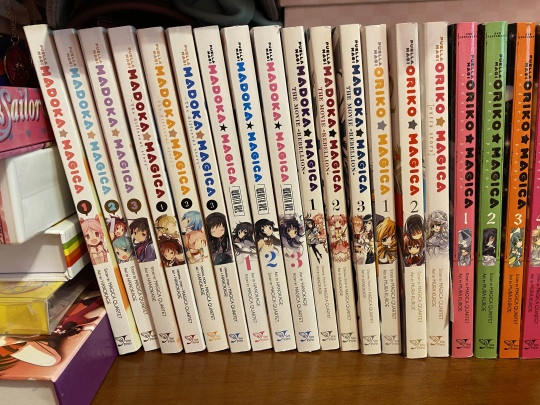
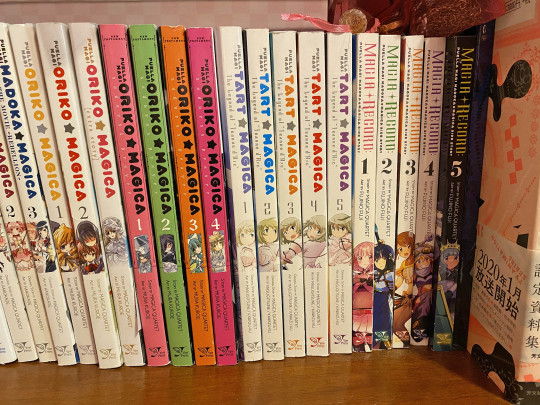
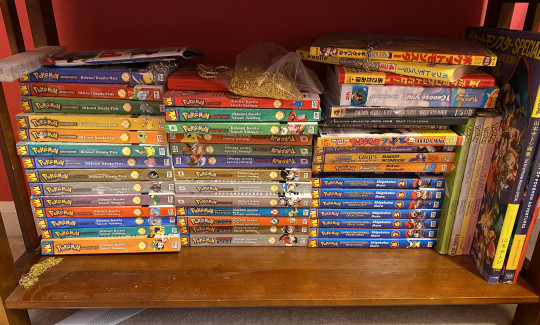
Pokemon Adventures (aka Pokemon Special) by Hidenori Kusaka and Mato/Satoshi Yamamoto. I own the complete set of the RBG, Yellow, GSC, FRLG, Emerald and HGSS arcs as well as a few volumes from the RS, DP, and Black/White arcs.
Various Pokemon 4koma (in Japanese)
Pokemon: I Choose You by Ryo Takamisaki
Phantom Thief Pokemon 7 by Miho Asada
The Rise of Darkrai by Ryo Takamisaki
Pokemon Diamond and Pearl Adventure by Shigekatsu Ihara
The Electric Tale of Pikachu by Toshihiro Ono
The Art of Pokemon Adventures by Satoshi Yamamoto (both English and Japanese versions)
Pokémon Mystery Dungeon: Ginji's Rescue Team by Makoto Mizobuchi
Pokemon Ranger and the Temple of the Sea by Makoto Mizobuchi



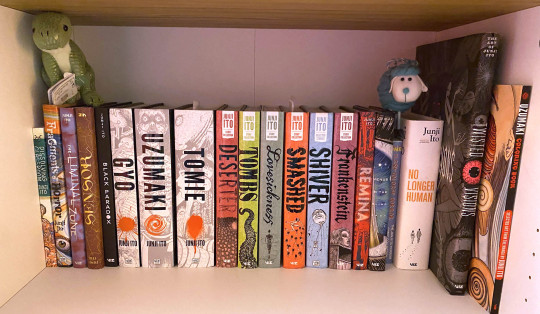
Various Junji Ito Manga:
Dissolving Classroom
Fragments of Horror
The Liminal Zone
Sensor
Black Paradox
Gyo
Uzumaki
Tomie
Deserter
Tombs
Lovesickness
Smashed
Shiver
Frankenstein
Remina
Venus in the Blind Spot
No Longer Human
Twisted Visions (artbook)
Uzumaki coloring book

Uzumaki (original printing) by Junji Ito
Museum of Terror by Junji Ito
Soichi by Junji Ito
The Drifting Classroom by Kazuo Umezu
JoJo's Bizarre Adventure: Battle Tendency by Hirohiko Araki
Orochi by Kazuo Umezu
Be Very Afraid of Kanoko Inuki! by Kanoko Inuki
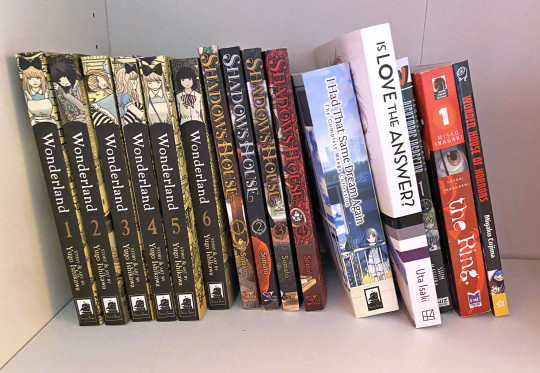
Wonderland by Yugo Ishikawa
Shadows House by Somato
I Had That Sane Dream Again by Yoru Sumino
Is Love the Answer? by Uta Isaki
Nightmare Inspector by Shin Mashiba
The Ring by Misao Inagaki
Wonder House of Horrors by Miyako Cojima
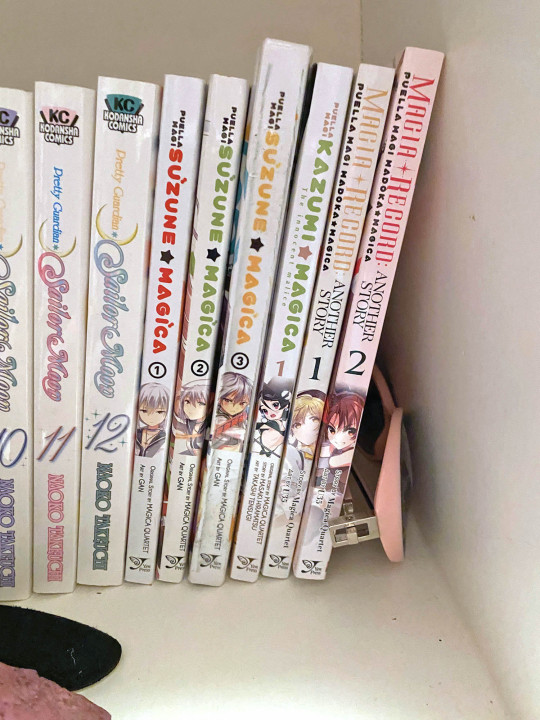
Puella Magi Suzune Magica by GAN
Puella Magi Kazumi Magica by Masaki Hiramatsu and Takashi Tensugi
Magia Record: Another Story by U35
I also have some manga in storage like Inuyasha and Kitchen Princess, but that's about it!
54 notes
·
View notes
Text








Akuma no Hanayome by Ikeda Etsuko and Ashibe Yuuho
10 notes
·
View notes
Text
Animation Night 134: Rintaro’s OVAs
Hi everyone! Welcome back to Animation Night.
Tonight we’re coming back to Rintaro, or りんたろう (or Shigeyuki Hayashi, but the pseudonym is near universal). This time I even found a picture of him!
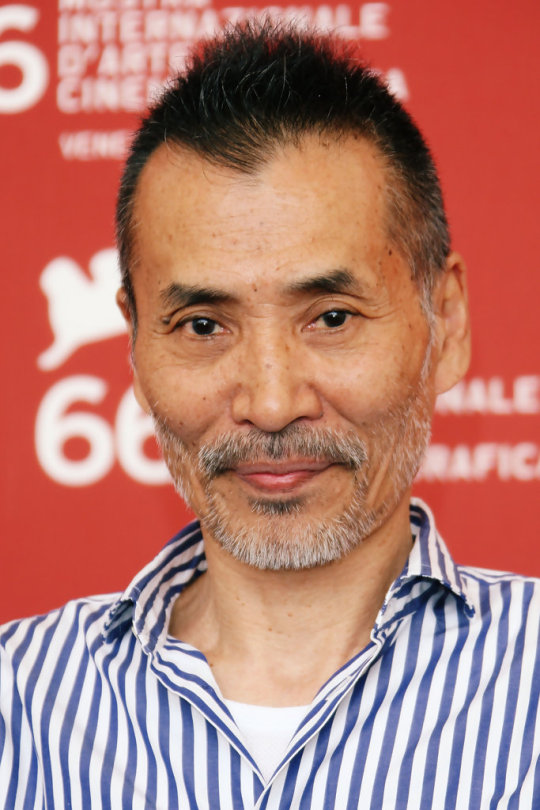
Rintaro one of the oldest of the anime old school to still be alive. He joined the anime industry as an inbetweener on Toei’s landmark film The Legend of the White Snake in 1958 and Astro Boy - but in his own right, he’s also a co-founder of Madhouse alongside people like Osamu Dezaki (Animation Night 95), Yoshiaki Kawajiri (25, 67) and Masao Maruyama (later, founder of MAPPA). He directed such classics as Space Captain Harlock (1978) and Galaxy Express 999 (AN62), he helped create the network of connections that led to Akira, he did a chapter of Tezuka’s Phoenix (AN80) he was still going strong in the 2000s with Metropolis (53).
He is, in short, one of the most significant directors in anime. And yet, to actually find out much about him beyond the films he’s made and the places he’s worked is surprisingly hard. Even in interview, his answers are a little vague. But then, the anime and manga industry are full of reclusive, shy creators. So let’s look at the films...
...or rather, let’s look at the OVAs! Look at them with our mouth eyes.
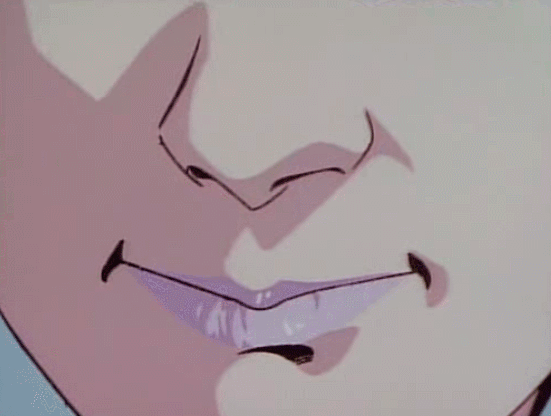
Pop.
Rintaro spent the late 70s and early 80s working not at Madhouse but at Toei, which was a chance for him to spread his wings outside of the shadow of Dezaki. This was the Captain Harlock era, and the Galaxy Express 999 era, the latter’s remarkable film building the important connection with Yoshinori Kanada and his ‘liquid fire’ effects.
In 82, after adapting renowned satirical novel I Am A Cat for a TV special, Rintaro came back to Madhouse - around the time of Dezaki’s Space Adventure Cobra. There, he would direct Genma Taisen (Harmageddon), which can in many ways be called the prototype for Akira, setting up the power trio of Otomo, Koji Morimoto and Takashi Nakamura. I’ll be screening that for Animation Night before too long, so more on that then (or just read Watzky’s article!).
As Dezaki stepped back, Madhouse entered the era that made it famous, what we could call the ‘auteur era’. Riding the OVA boom, they animated dozens of sci-fi films, OVAs and TV shows by a variety of directors. Their style tended to emphasise static detail with bursts of complex animation; chiaroscuro night settings with bright lights driven by background animation. Rintaro was one of their stars.
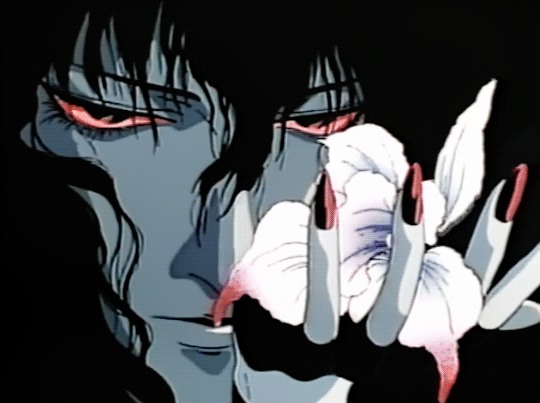
So this evening we’re going to pick out two of his works from this period in the new OVA format...
Let’s start with Bride of Deimos (悪魔 (デイモス)の花嫁). (Unfortunately I can’t display ruby text on Tumblr, but imagine that デイモス is written above the first two kanji.)
Bride of Deimos was an interesting beast: a shōjo horror manga by writer Etsuko Ikeda and illustrator Yuuho Ashibe with a a very classic-shōjo, Year 24 Group-esque visual style. (Beyond ‘authors of this manga’, it seems almost impossible to find out anything about either.) If I’m reading the plot summary right, revolves around a high school girl called Minako, who is the reincarnation of a demon Venus, the twin sister of an incestuous demon named Deimos; she is reincarnating because was executed by the demons for her incest crimes but the original soul seems to be out there somewhere? Deimos wants to bring Minako back to the underworld so Venus can possess her body again; Minako would prefer not to, and she’s got a lot of jealous people and suitors to fend off in the meantime thanks.
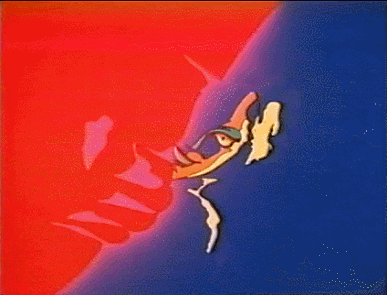
The manga ran a solid 26 years, from 1974 all the way to 1990. Rintaro could obviously not adapt something of that scope, and his 1988 OVA excerpts just one chapter from the whole epic for a half-hour OVA. It revolves around a brother-sister pair, the brother raising orchids and taking care of a disabled sister, who are both very yandere over each other. Into this whole mess stumbles Minako.
So expect a lot of very gothic imagery; it’s worth noting that Madhouse had adapted Vampire Hunter D just a few years earlier, and I think you can see the influence in its character design. There’s at least one very elaborate sequence of background animation which you can see above; unfortunately sakugabooru do not seem to know who animated it.
And then, just a few years later, we have Teito Monogatari (帝都物語), known in English as Doomed Megalopolis.
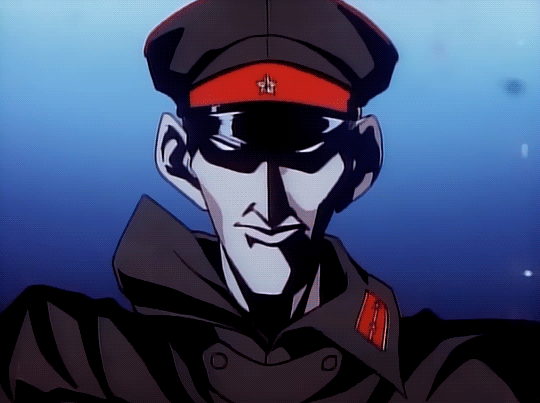
The original Teito Monogatari (1983-7) was a sprawling historical epic serial novel crossing basically the entire 90s, following the occult works of an immortal warlord of the Taira clan who led a failed rebellion against the central government (the same Taira clan whose fall is chronicled in the Heike Monogatari, c.f. Animation Night 91) and has now become a ghost serving the same empire. In the present, he is succeeded by Yasunori Katō, a former soldier in the imperial Japanese army who is in fact a vengeful oni working for 90 years to bring about the downfall of the Japanese Empire, bringing him into conflict with a long list of historical figures...
His ruinous ambitions bring him into conflict with some of 20th century Japan's greatest minds including industrialist Eiichi Shibusawa, onmyoji Abe no Seimei's descendant Yasumasa Hirai, authors Koda Rohan and Izumi Kyoka; physicist Torahiko Terada, and author Yukio Mishima. The resulting conflict, involving science, magic and politics; spans 90 years of Japan's history.
The story begins near the end of the Meiji period and ranges through the rest of the century. It reinvents major events such as the Great Kantō earthquake [in the story, the work of Katō and his allies], the founding of Japan's first subway, the February 26 Incident, the firebombing raids, the signing of the 1960 US Security Pact, and the ritual suicide of Yukio Mishima. The narrative finally reaches its climax in 1998, the 73rd year of a fictional Shōwa period.
The overall structure of the narrative seems to be that Katō comes up with various dastardly plans to destroy Tokyo, and is stopped by these historical figures (and original characters), deferring the destruction of Tokyo to later and later dates. In that regard it seems to fit the onryō mode, where the monster really is a victim of something terrible but nevertheless needs to be stopped. How that reflects on the subject of nationalism it raises so centrally, I’m not sure, and I’m curious to find out! e.g. it’s curious to me that it’s the villain Kato, despite fighting on behalf of indigenous people crushed by Japan, who dresses in the sinister, Nazi-like uniform of an Imperial Japanese Army officer.
This story proved wildly popular, and caused a resurgence of interest in mysticism, such as onmyōdō and feng shui, as well as the classic figure of the oni. It inspired numerous adaptations (one by Takashi Miike!) and subsequent works in the same vein in literature and manga.
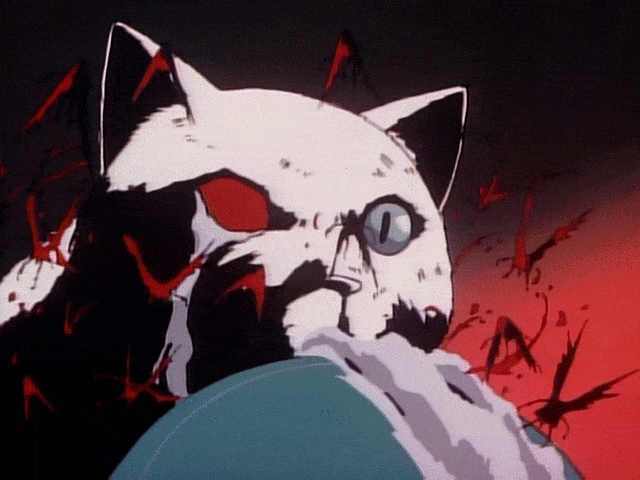
By the time Rintaro got to it, there had already been one successful tokusatsu adaptation of the first four chapters in 1988 by Toho, which had received wide acclaim. There had also been a certain OVA called Urotsukidōji, discussed back on Animation Night 69, which proved that sex and violence were very in - and as a result, this OVA went a lot harder than earlier Rintaro works or indeed previous adaptations of Teito Monogatari. Hoping to distinguish his take from previous adaptations, Rintaro emphasised the supernatural aspects - the things it was possible to display with elaborate effects animation. And thus animators like Tatsuyuki Tanaka provided suitably gruesome imagery.
The series spans four episodes, each about forty minutes, all overseen by Rintaro but directed respecitively Kazuyoshi Katayama, Koichi Chigira, Kazunari Kume and Masashi Ikeda. Like Toho’s take, it focuses on the first four chapters, spanning the period 1912-1928, in which the Meiji government was rapidly industrialising Japan and transforming it into a colonial power to stand against the Europeans; not long before the story starts, Japan had annexed Korea in 1910. Beyond his earthquake shenanigans, Katō schemes to possess a girl called Yukari Tatsumiya and her daughter Yukiko. A full-on wizard war ensues.
And I think that’s enough time writing. So, if you will join me tonight, we’ll be watching Bride of Deimos followed by all four episodes of Teito Monogatari (Doomed Megalopolis)! Starting shortly on twitch.tv/canmom - hope to see you there!
6 notes
·
View notes
Note
While your here and I know you probably posted it awhile ago but I Wana know bnha 2-b ocs quirks mostly how they work
Here is a list with a small explanation of each quirk + Photo reference!
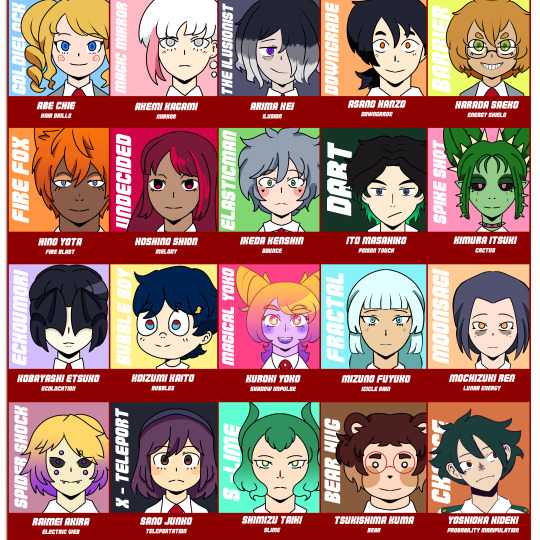
Abe Chie / Goldielock (F) / Hair Drills: Her hair can turn as hard as steel and rotate like drills
Akemi Kagami / Magic Mirror (F) Mirror: She can temporarily copy the quirk of whatever person is being reflected in her eyes.
Arima Kei / The Ilusionist (M) /Ilusion: He can make Auditory, Visual Ilusions
Asano Hanzo / Downgrade (M) / Downgrade: He can make a Quirk loose power or revert to a more implistic version of the quirk
Harada Saeko / Barrier (F) / Energy shield: She can make shields out of her vital energy, the more resistant they are the more exhausted she will be after.
Hino Yota / Firefox (M) / Fire blast: he can create fireballs and shoot them at oponets.
Hoshino Shion / (Undecided) (Genderfluid) / Melody : They can produce hypnotic melodies that force the oponent to dance uncontrollably.
Ikeda Kenshin / Elasticman (M) / Bounce: His body can turn into a rubbery bouncy material that also allows him to strech his limbs.
Ito Masahiko / Dart (M) / Poison Touch: His hands secrate a poison that can go from paralizing people to deeplyy injuring someone.
Kimura Itsuki /Spike Shot (M) / Cactus: His body works as a cactus. He can generate spikes and shoot them as if they were proyectiles.
Kobayashi Etsuko / Echoumori (F) / Echolocation: Just like bats she can percive her souroundings by Echolocation. She is very sensitive to loud noises.
Koizumi Kaito / Bubble Boy (M) / Bubbles: He can make resistant bubbles to trap oponets.
Kuroki Yoko / Magical Yoko (F) / Shadow Impulse: A shadowy figure can take contol of her body to increas her physical strength, speed and overall abilities. She cannot full control her impulses on this state.
Mizuno Fuyuko / Fractal (F) / Icicle rain: She can generate Icicle spikes and throw them at people as proyectiles.
Mochizuki Ren / Moonsagi (Agender) / Lunar energy: Moonlight increases their phisical abilities. They are very tired during the day as a side effect.
Raimei Akira / SpiderShock (NB) / Electric Web: They can geerate a restant spider web that is constantly electrified and can shock opopnets.
Sano Junko / X-Teleport (F) / Teleportation: She can teleport to wherever she can see. To do this she must place her arms formig an "X shape"
Shimizu Taiki / S-Lime (M) / Slime: He can generate Sticky slime to trap his oponents.
Tsukishima Kuma / Bear Hug (M) / Bear: He can do whatever a bear can.
Yoshioka Hideki / Chance (M) / Probability manipulation: He can alter the chance of something happening. However he cannot make something 100% or 0% there is always a bit of chance involved.
4 notes
·
View notes
Video
Ryoji Ikeda "supersymmetry" from YCAM on Vimeo.
Ryoji Ikeda "supersymmetry" (2014/Commissioned by YCAM)
supersymmetry.ycam.jp
Concept, Composition: Ryoji Ikeda
in collaboration with
Programming, Computer Graphics: Norimichi Hirakawa, Tomonaga Tokuyama, Yoshito Onishi
Mechanics/Optics/Device Design: Norimichi Hirakawa
Computer System Design: Tomonaga Tokuyama
Technical Management: Norimichi Hirakawa, Tomonaga Tokuyama
Electronics Design: Yoshito Onishi
Curator: Kazunao Abe (YCAM)
Co-curator: Patrick Gyger (Le Lieu Unique)
Yamaguchi Center for Arts and Media [YCAM]
Assistant Curator: Tsubasa Nishi
Construction Supervision: Richi Owaki
Sound Programming: Satoshi Hama
Device Design/Set-up: Richi Owaki, Keina Konno
Sound: Satoshi Hama, Etsuko Nishimura
System Engineering: Yohei Miura
Lighting Design: Fumie Takahara
Technical Management: Clarence Ng
Public Relations: Miyuki Tanaka
Documentation: Ryuichi Maruo, Tomoya Watanabe
Signage Operation: Naomi Kakuda
Education: Kiyoshi Suganuma
Ryoji Ikeda Studio
Creative Director: Emmanuelle de Montgazon
Administrative Assistant: Yuko Higaki
Mechanics/Electronics Design: Koichiro Mori
Shutter Device Set-up Support: Makoto Hirabayashi
Graphic Design: Kazuya Kondo
Organized by Yamaguchi City Foundation for Cultural Promotion
In association with Yamaguchi City, Yamaguchi City Board of Education
supported by the Agency for Cultural Affairs Government of Japan in the fiscal 2014, Institut Français du Japon and the partnership Institut Français-Ville de Nantes (France), THE ASAHI SHIMBUN FOUNDATION
Cooperated by Gallery Koyanagi,Tokyo
Equipment cooperation Mix Wave,Inc. , Bell-Park Co.,Ltd.
Co-developed with YCAM InterLab
Co-produced withLe lieu unique, scène nationale de Nantes with the Support of the City of Nantes and the Ministry of Culture and Communication (France)
Produced by Yamaguchi Center for Arts and Media [YCAM] , Ryoji Ikeda Studio
0 notes
Text

Akuma no Hanayome (drawings by Yuuho Ashibe and story by Etsuko Ikeda)
Awww, I’M a bit obsessed with this manga (I’m reading it slowly cause I don’t want to finish it in one go. Bu, ARGH, It’s SO good).
4 notes
·
View notes
Photo
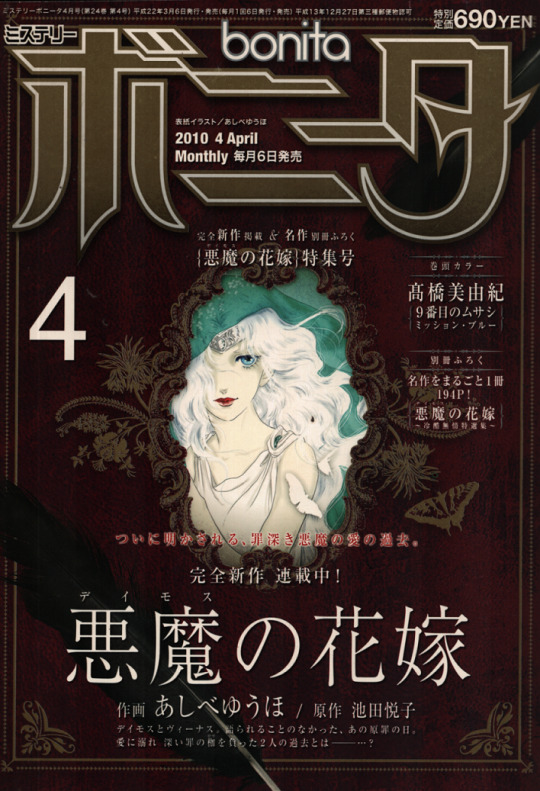
Bride of Deimos - Etsuko Ikeda and Yuho Ashibe
Mystery Bonita 04/10 Cover
#Bride of Deimos#Deimos no Hanayome#Deimos no Hanayome Saishuushou#Etsuko Ikeda#Yuho Ashibe#2010s#Mystery Bonita#ephemera
48 notes
·
View notes
Text

Ayako | 妖子
Riyoko Ikeda & Etsuko Ikeda
5 notes
·
View notes
Note
If DVHS were mythical creatures, what would they be? :D Can be obscure!
Some of these are Stretches bc I couldn't really think of anything ^^' I got all these from here
Abe Fumito: Phoenix
Aoyama Nozomu: Poltergeist
Fujimoto Hidekazu: Banshee
Hamasaki Utako: Siren
Ikeda Kazuhiko: Will-o-the-wisp
Ishikawa Camila: Vampire
Kadoshima Yasu: Nymph
Maeda Hayao: Werewolf
Matsumoto Takeshi: Elf
Nakamura Ikuo: Incubus
Oshiro Amaya: Angel
Rikimaru Kirika: Medusa
Saito Kagami: Valkyrie
Sasaki Hanayo: Dryad
Ueda Miyuki: Yuki-onna
Yoshida Etsuko: Poltergeist
#answered ask#headcanons#fumito abe#nozomu aoyama#hidekazu fujimoto#utako hamasaki#camila ishikawa#kazuhiko ikeda#yasu kadoshima#hayao maeda#takeshi matsumoto#ikuo nakamura#amaya oshiro#kirika rikimaru#kagami saito#hanayo sasaki#miyuki ueda#etsuko yoshida#danganronpa#dvhs#link
2 notes
·
View notes
Photo
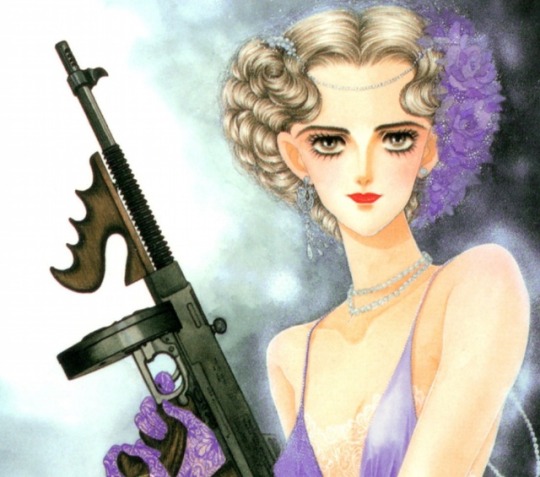

Itoshi no Gan Gan - Ikeda Etsuko and Ikesumi Chieko
#ikesumi chieko#chieko ikesumi#ikeda etsuko#etsuko ikeda#vintage manga#josei manga#90s manga#prohibition era#girls with guns
814 notes
·
View notes
Note
TELL ME ABOUT THE MANGA-ONLY SERIES!!!!
Okay! I've read way more manga than I've watched anime; for some reason it's easier for my ADHD-addled brain to focus on reading than watching stuff, lol. So as a result I've read a couple hundred manga series (mostly horror, lol) whereas I've only seen a couple dozen anime series.
Anyway, here are some of my favorite manga-only series:
Plant Dolls by Yumiko Kawahara
Pet Shop of Horrors by Matsuri Akino
Literally everything Junji Ito has ever made (I have read everything of his available in English)
Franken Fran by Katsuhisa Kigitsu
A Cruel God Reigns by Moto Hagio
Zekkyou Gakkyuu by Emi Ishikawa
Bride of Deimos by Etsuko Ikeda
The Drifting Classroom by Kazuo Umezu
Helter Skelter by Kyoko Okazaki
Kasane by Daruma Matsuura
Kuro by Somato
Anything by Kanoko Inuki
The Horror Mansion by Nori Ochazuke
Shibito no Koe o Kiku ga Yoi by Sachiko Uguisu
Anything else by Sachiko Uguisu
Puella Magi Tart Magica by Masugitsune
Orochi by Kazuo Umezu
Ibitsu by Haruto Ryou
Claymore by Norihiro Yagi (including this on the manga-only series list despite it having an anime because I've never seen the anime)
Parasyte by Hitoshi Iwaaki (including this on the manga-only series list despite it having an anime because I've never seen the anime)
Life by Keiko Suenobu
The vast majority of these are horror manga, so take that as my recommendation if you like that genre, lol.
83 notes
·
View notes